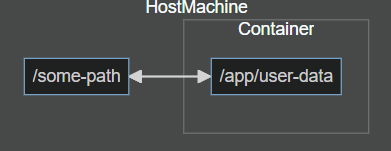Types of data
Container and Image Data
Container Data
Data can be stored inside containers as files, just as you would normally do on your local development machine.
However, once a container is removed, the data will be lost.
Note
Stopping and restarting a container will not delete your data within that container.
Volumes
- Volumes are folders on your host machine hard drive which are mounted (“made available”, mapped) into containers.

- Volumes persist if a container shuts down. If a container (re-)starts and mounts a volume, any data inside of that volume is available in the container.
- A container can write data into a volume and read data from it.
Defining Volumes
FROM node:14
WORKDIR /app
COPY package.json .
RUN npm install
COPY . .
EXPOSE 80
VOLUME [ "/app/feedback" ]
CMD ["node", "server.js"]
The VOLUME command specifies a path inside the container that will be treated as a volume. The mapping to the host’s file system is defined by the run command when starting a container.
Volumes & Bind Mounts
Terminal window
# Anonymous Volumedocker run -v /app/data ...
# Named Volumedocker run -v data:/app/data ...
# Bind Mountdocker run -v /path/to/code:/app/code
Volumes vs. Bind Mounts
Container / Volume Interaction
Summary
- Containers can read + write data. Volumes can help with data storage, Bind Mounts can help with direct container interaction.
- Containers can read + write data, but written data is lost if the container is removed.
- Volumes are folders on the host machine, managed by Docker, which are mounted into the container.
- Named Volumes survive container removal and can therefore be used to store persistent data.
- Anonymous Volumes are attached to a container - they can be used to save (temporary) data inside the container.
- Bind Mounts are folders on the host machine which are specified by the user and mounted into containers - like Named Volumes.